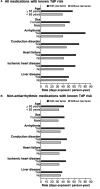Use of QT Prolonging Medications by Hemodialysis Patients and Individuals Without End-Stage Kidney Disease
- PMID: 32578475
- PMCID: PMC7670513
- DOI: 10.1161/JAHA.120.015969
Use of QT Prolonging Medications by Hemodialysis Patients and Individuals Without End-Stage Kidney Disease
Abstract
Background The rate of sudden cardiac death in the hemodialysis population exceeds that of the general population by >20-fold. Hemodialysis patients may be particularly susceptible to sudden cardiac death provoked by drug-induced QT prolongation because of their substantial cardiovascular disease burden, exposure to electrolyte shifts during dialysis, and extensive polypharmacy. However, population-specific data regarding the frequency and patterns of QT prolonging medication use are limited. Methods and Results We conducted a descriptive drug utilization study using 3 administrative databases, the United States Renal Data System, MarketScan, and Medicare claims. We characterized the extent and patterns of QT prolonging medication use by adult hemodialysis patients and individuals without end-stage kidney disease annually from 2012 to 2016. We also identified instances of high-risk QT prolonging medication use among hemodialysis patients. In total, 338 515 hemodialysis patients and 40.7 million individuals without end-stage kidney disease were studied. Annual utilization rates of QT prolonging medications with known torsades de pointes risk in hemodialysis patients were ~1.4 to ~2.5 times higher than utilization rates in individuals without end-stage kidney disease. Hemodialysis patients with demographic and clinical risk factors for drug-induced QT prolongation were exposed to medications with known torsades de pointes risk more often than patients without risk factors. Conclusions Hemodialysis patients use QT prolonging medications with known torsades de pointes risk more extensively than individuals without end-stage kidney disease. Given the widespread use and instances of high-risk prescribing, future studies evaluating the cardiac safety of these drugs in the hemodialysis population are needed.
Keywords: Hemodialysis; QT prolonging medications; patterns of use.
Figures




References
-
- Huikuri HV, Castellanos A, Myerburg RJ. Sudden death due to cardiac arrhythmias. N Engl J Med. 2001;1473–1482. - PubMed
-
- Paoletti E, Specchia C, Di Maio G, Bellino D, Damasio B, Cassottana P, Cannella G. The worsening of left ventricular hypertrophy is the strongest predictor of sudden cardiac death in haemodialysis patients: a 10 year survey. Nephrol Dial Transplant. 2004;1829–1834. - PubMed
-
- Mark PB, Johnston N, Groenning BA, Foster JE, Blyth KG, Martin TN, Steedman T, Dargie HJ, Jardine AG. Redefinition of uremic cardiomyopathy by contrast‐enhanced cardiac magnetic resonance imaging. Kidney Int. 2006;1839–1845. - PubMed
Publication types
MeSH terms
Grants and funding
LinkOut - more resources
Full Text Sources
Medical

